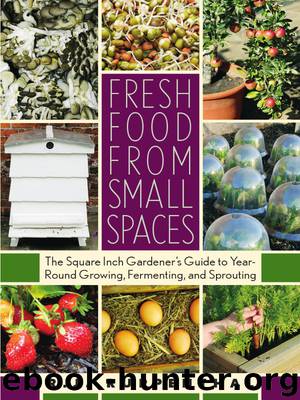Fresh Food from Small Spaces by R.J. Ruppenthal

Author:R.J. Ruppenthal [Ruppenthal, R.J.]
Language: eng
Format: epub, pdf
Tags: ebook, book
ISBN: 9781603581455
Publisher: Chelsea Green Publishing
Published: 2011-02-07T22:00:00+00:00
EAT YOUR SPROUTS!
I have a confession to make. Earlier in this book, I made a claim that city residents with an average-sized apartment or condominium can raise up to 10 to 20 percent of their own fresh food. This, I now confess, was a lie. You can actually grow an even higher percentage of your own fresh food, depending on what percentage of your diet can consist of fresh sprouts! There is an old saying that “man does not live by bread alone.” This is probably true of sprouts also, especially given that you would get weary of eating nothing but sprouts day in and day out (even though, nutritionally, you might meet most of your dietary needs this way). My point is this: If you wanted to grow enough sprouts to live on, using the space in your apartment or condo, you could probably do so. There is simply no other food that you can produce so much of, in so small a space, so quickly, and with such a potent nutritional output. With sprouts, the limiting factor is not space, or light, or soil, or even water. The limiting factor is: How many sprouts can you really eat?
Luckily, I have good news here. There are many different kinds of sprouts, and they are a lot easier to eat than you might think. Sometimes when people visit our home, I show off my automatic sprouter and explain to them how I can grow several pounds of nutritious vegetables every single week. Each time, the houseguests seem suitably impressed. Then they pause politely, and they all ask the same question: What do you do with that many sprouts?
Using sprouts as a major food source is not an integral part of our culinary traditions, though several Asian cultures use bean sprouts as a vegetable. With the exception of wheatgrass sprouts, which are juiced, it is a challenge to incorporate an armload of sprouts into the foods we like to eat, and even tougher to structure a dish around them. Yet pound for pound, sprouts provide more nutrition than many vegetables, are much simpler and quicker to grow, and really do taste great. So it is worthwhile to consider how best to utilize these underrated foods.
We can loosely classify sprouts into three main categories: grain sprouts, bean sprouts, and salad (or sandwich) sprouts. Grains to sprout include wheat, barley, rye, and oats. You can soak these grains and sprout them for just a day or two before eating, in which case they are more of a grain than a vegetable. But as soon as cereal grains sprout into long, green shoots they can no longer be enjoyed as grains, and essentially become more of a grass. Sprouted cereal grasses are normally juiced, since they are too fibrous to digest. Beans, like grains, can be sprouted for a day or two and then eaten as beans. Sprouted lentils and peas are delicious when eaten raw, although I tend to think that cooking improves other types of sprouted beans (though some people like eating all of them raw).
Download
Fresh Food from Small Spaces by R.J. Ruppenthal.pdf
This site does not store any files on its server. We only index and link to content provided by other sites. Please contact the content providers to delete copyright contents if any and email us, we'll remove relevant links or contents immediately.
| Container Gardening | Hydroponics |
| Organic | Propagation & Cultivation |
| Topiary | Urban |
| Water Gardens & Ponds |
Turbulence by E. J. Noyes(7918)
The Thirst by Nesbo Jo(6806)
Gerald's Game by Stephen King(4554)
Be in a Treehouse by Pete Nelson(3922)
Marijuana Grower's Handbook by Ed Rosenthal(3605)
The Sprouting Book by Ann Wigmore(3529)
The Red Files by Lee Winter(3356)
The Remains of the Day by Kazuo Ishiguro(3279)
Sharp Objects: A Novel by Gillian Flynn(2939)
Christian (The Protectors Book 1) by L. Ann Marie(2644)
Organic Mushroom Farming and Mycoremediation by Tradd Cotter(2616)
The Culinary Herbal by Susan Belsinger(2420)
Stone Building by Kevin Gardner(2336)
The Starter Garden Handbook by Alice Mary Alvrez(2269)
Lilac Girls by Martha Hall Kelly(2243)
The Unlikely Pilgrimage of Harold Fry by Rachel Joyce(2202)
The Lean Farm Guide to Growing Vegetables: More In-Depth Lean Techniques for Efficient Organic Production by Ben Hartman(2084)
Urban Farming by Thomas Fox(2054)
Backyard Woodland by Josh VanBrakle(1879)
